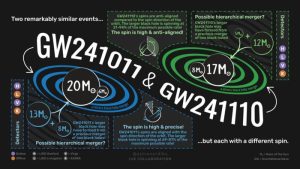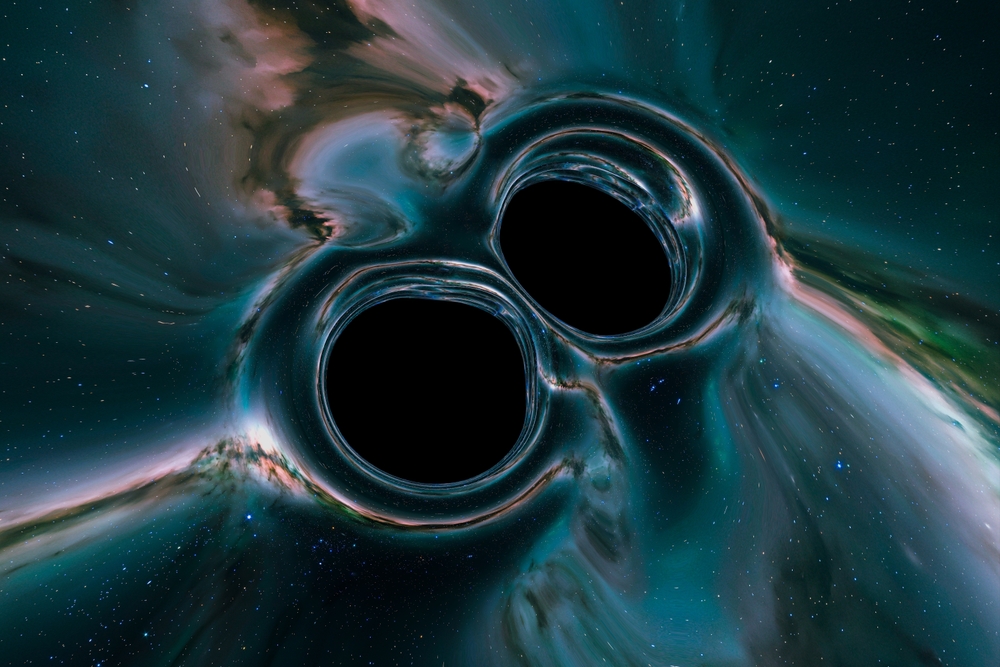In a major leap forward in astrophysics, the international LIGO-Virgo-KAGRA collaboration announced the detection of two unusual black hole merger events, each revealing rare and puzzling spin properties.
These cosmic collisions, detected in October and November 2024, have given scientists new insights into how the most extreme objects in the universe form and evolve, and have even allowed researchers to test Einstein’s theory of general relativity with unprecedented precision.
Two newly reported black hole merger events, named GW241011 and GW241110, were detected just a month apart but exhibited dramatically different characteristics.
But both challenge what scientists thought they knew about black holes, hinting that some of these giant universes may be “second generation” black holes born from previous mergers.
First signal: a rapidly rotating black hole
The first black hole merger event, GW241011, zipped through space and time on October 11, 2024, traveling nearly 700 million light years before reaching Earth. It was created by the collision of two black holes with masses approximately 17 and 7 times that of the Sun.
What set GW241011 apart was the incredible rotation of the larger black hole, one of the fastest ever observed. This rotation provided scientists with a rare opportunity to examine the details of space-time distortions.
Using advanced algorithms and waveform modeling, the researchers confirmed that this event perfectly matched Einstein’s predictions of a rotating black hole, first described mathematically by Roy Carr in the 1960s.
The signal also contains higher “harmonic” frequencies (overtones similar to those of musical instruments), and is the third time such a signature has been detected.
These harmonics provided another successful test of general relativity, showing how gravitational waves encode subtle information about the black hole’s structure.
Second event: Reverse rotation
Just four weeks later, on November 10, 2024, LIGO, Virgo, and KAGRA detectors captured a second event, GW241110, which occurred at a staggering distance of 2.4 billion light-years.
This black hole merger, which involved objects with approximately 16 and 8 solar masses, took a shocking turn. That is, the larger black hole was rotating in the opposite direction to its orbit.
Such anti-aligned spins are extremely rare and suggest that the system was not formed from two stars evolving together, but from black holes dynamically assembling in a crowded environment, such as a dense star cluster.
This reverse rotation may therefore be the first clear evidence of hierarchical coalescence. In hierarchical mergers, black holes produced in a single collision coalesce again to form a new generation of heavier black holes.
Signs of a “second generation” black hole
Both events share important characteristics that indicate this hierarchical merger scenario. Each black hole was much more massive than its companion and featured a single black hole spinning at high speed. This pattern suggests a complex history, including previous conflicts.
Astrophysicists believe these systems likely formed near dense spaces in the universe, such as globular clusters or galactic centers, where black holes collide multiple times due to repeated gravitational interactions.

In such a bustling environment, black holes do not remain isolated, but rather coalesce, spin up, and become heavier with each generation.
These discoveries mark a turning point in black hole research. Of the nearly 300 mergers detected since gravitational wave astronomy began, GW241011 and GW241110 are among the most unusual, providing strong evidence that the most violent events in the universe are likely recycled collisions.
A triumph of global collaboration
This detection was made possible through a collaboration between the LIGO Observatory in the United States, the Virgo Observatory in Italy, and the KAGRA Observatory in Japan. Together they form a global network that can detect distortions of spacetime smaller than a proton.
Now nearing the end of its fourth observation (O4), which began in May 2023, the LIGO-Virgo-KAGRA collaboration continues to push the limits of detection sensitivity.
Researchers have already identified hundreds of potential black hole mergers awaiting testing, each offering new windows into the dynamics of gravity, matter, and energy under the most extreme conditions imaginable.
Search for new particles
The implications of these discoveries go far beyond astrophysics. Rapidly rotating black holes like GW241011 are currently being used as natural laboratories to explore the possible existence of ultralight bosons. Ultralight bosons are hypothetical particles that could help explain dark matter and fill gaps in the Standard Model of particle physics.
If these particles existed, they would gradually siphon energy from the rotating black hole, causing it to spin more slowly over time. However, the observation that GW241011’s black hole is still an exceptionally fast spinner effectively rules out a wide range of ultralight bosonic masses.
The future of black hole science
The detection of these twins heralds the beginning of a new era in gravitational wave astronomy. Every time a black hole merger is observed, scientists are peeling back yet another layer of the universe’s most mysterious power.
Data from GW241011 and GW241110 will help researchers refine models of how massive stars die, how galaxies evolve, and how gravity behaves under conditions that push Einstein’s equations to their limits.
As the LIGO-Virgo-KAGRA collaboration prepares for future upgrades and observation runs, astronomers hope to discover even rarer and more complex phenomena.
Ultimately, each new detection translates abstract physics into observable reality. The story of black hole mergers is no longer theoretical. It is an unfolding cosmic story that continues to reshape our understanding of space, time, and the origins of the universe itself.
Source link

